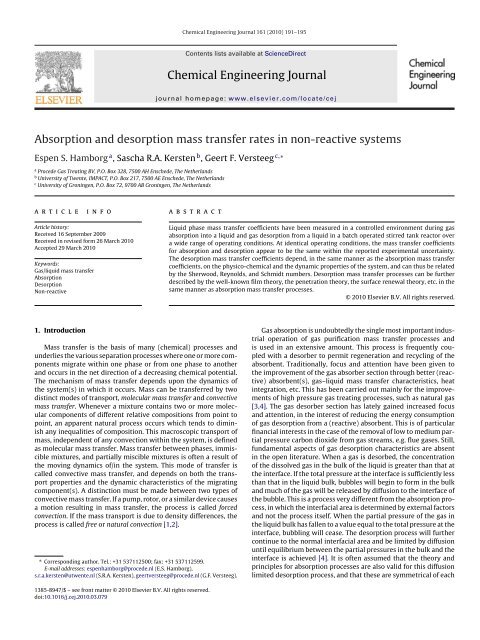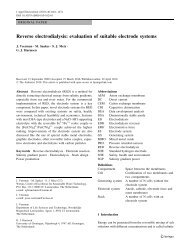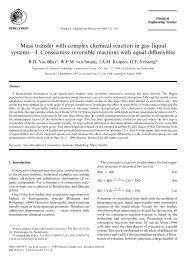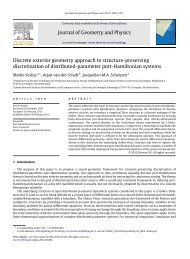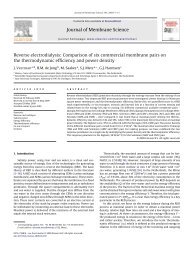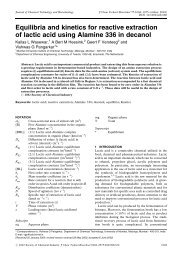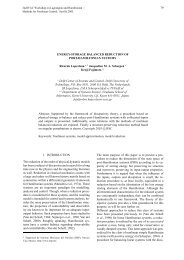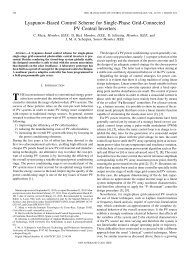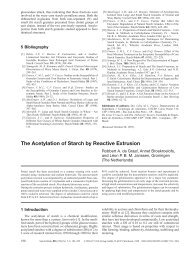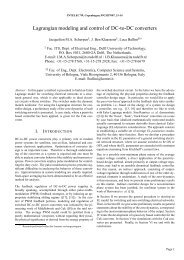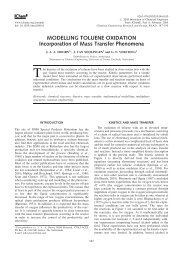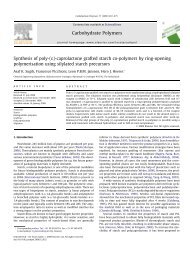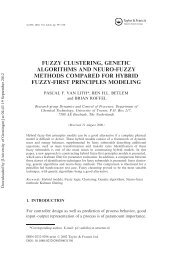Absorption and desorption mass transfer rates in non-reactive ... - ITM
Absorption and desorption mass transfer rates in non-reactive ... - ITM
Absorption and desorption mass transfer rates in non-reactive ... - ITM
You also want an ePaper? Increase the reach of your titles
YUMPU automatically turns print PDFs into web optimized ePapers that Google loves.
Chemical Eng<strong>in</strong>eer<strong>in</strong>g Journal 161 (2010) 191–195<br />
Contents lists available at ScienceDirect<br />
Chemical Eng<strong>in</strong>eer<strong>in</strong>g Journal<br />
journal homepage: www.elsevier.com/locate/cej<br />
<strong>Absorption</strong> <strong>and</strong> <strong>desorption</strong> <strong>mass</strong> <strong>transfer</strong> <strong>rates</strong> <strong>in</strong> <strong>non</strong>-<strong>reactive</strong> systems<br />
Espen S. Hamborg a , Sascha R.A. Kersten b , Geert F. Versteeg c,∗<br />
a Procede Gas Treat<strong>in</strong>g BV, P.O. Box 328, 7500 AH Enschede, The Netherl<strong>and</strong>s<br />
b University of Twente, IMPACT, P.O. Box 217, 7500 AE Enschede, The Netherl<strong>and</strong>s<br />
c University of Gron<strong>in</strong>gen, P.O. Box 72, 9700 AB Gron<strong>in</strong>gen, The Netherl<strong>and</strong>s<br />
article<br />
<strong>in</strong>fo<br />
abstract<br />
Article history:<br />
Received 16 September 2009<br />
Received <strong>in</strong> revised form 26 March 2010<br />
Accepted 29 March 2010<br />
Keywords:<br />
Gas/liquid <strong>mass</strong> <strong>transfer</strong><br />
<strong>Absorption</strong><br />
Desorption<br />
Non-<strong>reactive</strong><br />
Liquid phase <strong>mass</strong> <strong>transfer</strong> coefficients have been measured <strong>in</strong> a controlled environment dur<strong>in</strong>g gas<br />
absorption <strong>in</strong>to a liquid <strong>and</strong> gas <strong>desorption</strong> from a liquid <strong>in</strong> a batch operated stirred tank reactor over<br />
a wide range of operat<strong>in</strong>g conditions. At identical operat<strong>in</strong>g conditions, the <strong>mass</strong> <strong>transfer</strong> coefficients<br />
for absorption <strong>and</strong> <strong>desorption</strong> appear to be the same with<strong>in</strong> the reported experimental uncerta<strong>in</strong>ty.<br />
The <strong>desorption</strong> <strong>mass</strong> <strong>transfer</strong> coefficients depend, <strong>in</strong> the same manner as the absorption <strong>mass</strong> <strong>transfer</strong><br />
coefficients, on the physico-chemical <strong>and</strong> the dynamic properties of the system, <strong>and</strong> can thus be related<br />
by the Sherwood, Reynolds, <strong>and</strong> Schmidt numbers. Desorption <strong>mass</strong> <strong>transfer</strong> processes can be further<br />
described by the well-known film theory, the penetration theory, the surface renewal theory, etc. <strong>in</strong> the<br />
same manner as absorption <strong>mass</strong> <strong>transfer</strong> processes.<br />
© 2010 Elsevier B.V. All rights reserved.<br />
1. Introduction<br />
Mass <strong>transfer</strong> is the basis of many (chemical) processes <strong>and</strong><br />
underlies the various separation processes where one or more components<br />
migrate with<strong>in</strong> one phase or from one phase to another<br />
<strong>and</strong> occurs <strong>in</strong> the net direction of a decreas<strong>in</strong>g chemical potential.<br />
The mechanism of <strong>mass</strong> <strong>transfer</strong> depends upon the dynamics of<br />
the system(s) <strong>in</strong> which it occurs. Mass can be <strong>transfer</strong>red by two<br />
dist<strong>in</strong>ct modes of transport, molecular <strong>mass</strong> <strong>transfer</strong> <strong>and</strong> convective<br />
<strong>mass</strong> <strong>transfer</strong>. Whenever a mixture conta<strong>in</strong>s two or more molecular<br />
components of different relative compositions from po<strong>in</strong>t to<br />
po<strong>in</strong>t, an apparent natural process occurs which tends to dim<strong>in</strong>ish<br />
any <strong>in</strong>equalities of composition. This macroscopic transport of<br />
<strong>mass</strong>, <strong>in</strong>dependent of any convection with<strong>in</strong> the system, is def<strong>in</strong>ed<br />
as molecular <strong>mass</strong> <strong>transfer</strong>. Mass <strong>transfer</strong> between phases, immiscible<br />
mixtures, <strong>and</strong> partially miscible mixtures is often a result of<br />
the mov<strong>in</strong>g dynamics of/<strong>in</strong> the system. This mode of <strong>transfer</strong> is<br />
called convective <strong>mass</strong> <strong>transfer</strong>, <strong>and</strong> depends on both the transport<br />
properties <strong>and</strong> the dynamic characteristics of the migrat<strong>in</strong>g<br />
component(s). A dist<strong>in</strong>ction must be made between two types of<br />
convective <strong>mass</strong> <strong>transfer</strong>. If a pump, rotor, or a similar device causes<br />
a motion result<strong>in</strong>g <strong>in</strong> <strong>mass</strong> <strong>transfer</strong>, the process is called forced<br />
convection. If the <strong>mass</strong> transport is due to density differences, the<br />
process is called free or natural convection [1,2].<br />
∗ Correspond<strong>in</strong>g author. Tel.: +31 537112500; fax: +31 537112599.<br />
E-mail addresses: espenhamborg@procede.nl (E.S. Hamborg),<br />
s.r.a.kersten@utwente.nl (S.R.A. Kersten), geertversteeg@procede.nl (G.F. Versteeg).<br />
Gas absorption is undoubtedly the s<strong>in</strong>gle most important <strong>in</strong>dustrial<br />
operation of gas purification <strong>mass</strong> <strong>transfer</strong> processes <strong>and</strong><br />
is used <strong>in</strong> an extensive amount. This process is frequently coupled<br />
with a desorber to permit regeneration <strong>and</strong> recycl<strong>in</strong>g of the<br />
absorbent. Traditionally, focus <strong>and</strong> attention have been given to<br />
the improvement of the gas absorber section through better (<strong>reactive</strong>)<br />
absorbent(s), gas–liquid <strong>mass</strong> <strong>transfer</strong> characteristics, heat<br />
<strong>in</strong>tegration, etc. This has been carried out ma<strong>in</strong>ly for the improvements<br />
of high pressure gas treat<strong>in</strong>g processes, such as natural gas<br />
[3,4]. The gas desorber section has lately ga<strong>in</strong>ed <strong>in</strong>creased focus<br />
<strong>and</strong> attention, <strong>in</strong> the <strong>in</strong>terest of reduc<strong>in</strong>g the energy consumption<br />
of gas <strong>desorption</strong> from a (<strong>reactive</strong>) absorbent. This is of particular<br />
f<strong>in</strong>ancial <strong>in</strong>terests <strong>in</strong> the case of the removal of low to medium partial<br />
pressure carbon dioxide from gas streams, e.g. flue gases. Still,<br />
fundamental aspects of gas <strong>desorption</strong> characteristics are absent<br />
<strong>in</strong> the open literature. When a gas is desorbed, the concentration<br />
of the dissolved gas <strong>in</strong> the bulk of the liquid is greater than that at<br />
the <strong>in</strong>terface. If the total pressure at the <strong>in</strong>terface is sufficiently less<br />
than that <strong>in</strong> the liquid bulk, bubbles will beg<strong>in</strong> to form <strong>in</strong> the bulk<br />
<strong>and</strong> much of the gas will be released by diffusion to the <strong>in</strong>terface of<br />
the bubble. This is a process very different from the absorption process,<br />
<strong>in</strong> which the <strong>in</strong>terfacial area is determ<strong>in</strong>ed by external factors<br />
<strong>and</strong> not the process itself. When the partial pressure of the gas <strong>in</strong><br />
the liquid bulk has fallen to a value equal to the total pressure at the<br />
<strong>in</strong>terface, bubbl<strong>in</strong>g will cease. The <strong>desorption</strong> process will further<br />
cont<strong>in</strong>ue to the normal <strong>in</strong>terfacial area <strong>and</strong> be limited by diffusion<br />
until equilibrium between the partial pressures <strong>in</strong> the bulk <strong>and</strong> the<br />
<strong>in</strong>terface is achieved [4]. It is often assumed that the theory <strong>and</strong><br />
pr<strong>in</strong>ciples for absorption processes are also valid for this diffusion<br />
limited <strong>desorption</strong> process, <strong>and</strong> that these are symmetrical of each<br />
1385-8947/$ – see front matter © 2010 Elsevier B.V. All rights reserved.<br />
doi:10.1016/j.cej.2010.03.079
192 E.S. Hamborg et al. / Chemical Eng<strong>in</strong>eer<strong>in</strong>g Journal 161 (2010) 191–195<br />
other. In that sense, the <strong>mass</strong> <strong>transfer</strong> of a migrat<strong>in</strong>g compound<br />
between a gas phase <strong>and</strong> a liquid phase should be equal at identical<br />
operat<strong>in</strong>g conditions dur<strong>in</strong>g the absorption <strong>and</strong> <strong>desorption</strong><br />
process. This is usually assumed <strong>and</strong> accepted; however, experimental<br />
validation <strong>in</strong> the open literature is extremely limited. In<br />
studies where absorption <strong>and</strong> <strong>desorption</strong> <strong>mass</strong> <strong>transfer</strong> processes<br />
have been studied <strong>and</strong> compared, the volumetric <strong>mass</strong> <strong>transfer</strong><br />
coefficients (k l a) have often been compared to one another <strong>and</strong> by<br />
such not the <strong>mass</strong> <strong>transfer</strong> coefficients (k l ). Discrepancies of the volumetric<br />
<strong>mass</strong> <strong>transfer</strong> coefficients have been observed <strong>and</strong> reported<br />
for absorption <strong>and</strong> <strong>desorption</strong> <strong>mass</strong> <strong>transfer</strong> processes; although,<br />
the <strong>in</strong>terfacial area (a) was not necessarily known or held constant<br />
[5–10]. The purpose of the current work is to obta<strong>in</strong> more fundamental<br />
<strong>in</strong>sights of absorption <strong>and</strong> <strong>desorption</strong> forced convective<br />
<strong>mass</strong> <strong>transfer</strong> processes by compar<strong>in</strong>g <strong>mass</strong> <strong>transfer</strong> coefficients<br />
(k l ) for absorption <strong>and</strong> <strong>desorption</strong> processes to one another over a<br />
wide range of identical operation conditions.<br />
2. Theory <strong>and</strong> experimental procedure<br />
Accord<strong>in</strong>g to <strong>mass</strong> <strong>transfer</strong> theories such as the (two-) film<br />
theory, the penetration theory, the surface renewal theory, etc.,<br />
the <strong>mass</strong> <strong>transfer</strong> of a process will depend on the diffusivity, D,<br />
<strong>and</strong> the convective motion (e.g. hydrodynamics) of the compounds<br />
<strong>in</strong>volved. The diffusivity is usually related to the <strong>mass</strong> <strong>transfer</strong> coefficient,<br />
k, by:<br />
k ∝ D r (1)<br />
where r usually varies between 0.5 <strong>and</strong> 1.0. The relation between<br />
the <strong>mass</strong> <strong>transfer</strong> coefficient <strong>and</strong> the motion of the components<br />
<strong>in</strong>volved can not be generally correlated, <strong>and</strong> depends upon geometries,<br />
stirrer/pump speed, etc. of the equipment used. Therefore,<br />
for a justified comparison of <strong>mass</strong> <strong>transfer</strong> <strong>in</strong> both directions over<br />
an <strong>in</strong>terface, the diffusivity D <strong>and</strong> the convective motion of the<br />
compounds <strong>in</strong>volved have to be kept constant. <strong>Absorption</strong> <strong>and</strong> <strong>desorption</strong><br />
measurements have been carried out <strong>in</strong> a stirred cell at<br />
identical temperature, stirrer speed, bulk volumes, solvent concentration,<br />
<strong>and</strong> <strong>in</strong>terfacial area <strong>in</strong> the present work. Although the<br />
comparable measurements were carried out at identical operat<strong>in</strong>g<br />
conditions, the operat<strong>in</strong>g conditions such as the hydrodynamics<br />
(stirrer speed <strong>and</strong> liquid levels), temperatures, <strong>and</strong> chemical compounds<br />
were changed <strong>in</strong> order to obta<strong>in</strong> a wide range of comparable<br />
measurements.<br />
It is common practice to describe the dependency of the experimentally<br />
observed <strong>mass</strong> <strong>transfer</strong> coefficients to the molecular<br />
diffusivity, viscosity, density, <strong>and</strong> hydrodynamics of the system by<br />
means of a relationship of dimensionless numbers for absorption<br />
measurements [11,12]. The well-known relation relat<strong>in</strong>g the Sherwood<br />
(Sh) number to the Reynolds (Re) <strong>and</strong> Schmidt (Sc) numbers<br />
applied to a stirred tank is:<br />
Sh = c1 + c2Re c3 Sc c4 (2)<br />
where:<br />
Sh = k ld s<br />
D<br />
Re = d2 s ω<br />
<br />
Sc = (5)<br />
D<br />
The constants c1, c2, c3, <strong>and</strong> c4 <strong>in</strong>Eq.(2) are dependent on<br />
the type of equipment used, e.g. geometries of the tank, stirrer<br />
type/speed, etc. From the results <strong>in</strong> the present work, it was concluded<br />
that the constant c1 could be neglected. The exponent c3of<br />
(3)<br />
(4)<br />
Fig. 1. Schematic draw<strong>in</strong>g of the experimental setup.<br />
the Re number can easily be determ<strong>in</strong>ed experimentally by variation<br />
of the Sh <strong>and</strong> Re number, i.e. variation of the stirrer speed, <strong>and</strong><br />
simultaneously keep<strong>in</strong>g the solute/solvent dependent Sc number<br />
constant. The coefficient c2 <strong>and</strong> the exponent c4 can be determ<strong>in</strong>ed<br />
by us<strong>in</strong>g different solutes/solvents at constant Re numbers,<br />
i.e. identical hydrodynamic conditions.<br />
The liquid phase <strong>mass</strong> <strong>transfer</strong> coefficient, k l was determ<strong>in</strong>ed<br />
for both physical absorption <strong>and</strong> <strong>desorption</strong> with the<br />
follow<strong>in</strong>g systems; carbon dioxide–water, oxygen–water, nitrous<br />
oxide–aqueous N-methyldiethanolam<strong>in</strong>e (MDEA), <strong>and</strong> nitrous<br />
oxide–aqueous diisopropanolam<strong>in</strong>e (DIPA). In this way, the solubilities<br />
of the gaseous compound <strong>in</strong> the liquid solution <strong>and</strong> the<br />
viscosities of the liquid solution could be varied over a wide<br />
range <strong>and</strong> thus cover<strong>in</strong>g different experimental conditions, i.e. Sc<br />
numbers. The diffusivity of the gaseous compounds <strong>in</strong> the liquid<br />
solutions varies with the viscosities of the solution [13], <strong>and</strong> alters<br />
the <strong>mass</strong> <strong>transfer</strong> coefficient accord<strong>in</strong>g to Eq. (1). A schematic presentation<br />
<strong>and</strong> specifications of the setup used are given <strong>in</strong> Fig. 1 <strong>and</strong><br />
Table 1. The reactor consisted of glass <strong>and</strong> sta<strong>in</strong>less steel metal,<br />
was thermostatted to with<strong>in</strong> ±0.1 K, <strong>and</strong> provided with 2-blade<br />
<strong>in</strong>dependently controlled stirrers <strong>in</strong> the gas <strong>and</strong> the liquid phase<br />
at fixed positions <strong>in</strong>side reactor. Both the reactor <strong>and</strong> the gas supply<br />
vessel were equipped with PT-100 temperature sensors <strong>and</strong><br />
high precision pressure transducers (Heise Model DXD, range 0–2<br />
bara). The maximum stirrer speed at which a visual smooth <strong>in</strong>terface<br />
could still be ma<strong>in</strong>ta<strong>in</strong>ed for the type of stirrers used was at<br />
about 2.62 revolutions per second (rps). By the use of a high purity<br />
s<strong>in</strong>gle component gas dur<strong>in</strong>g each measurement, gas phase <strong>mass</strong><br />
<strong>transfer</strong> resistance could be neglected. In the case of the carbon<br />
dioxide–water system; the reaction rate between carbon dioxide<br />
<strong>and</strong> water <strong>and</strong> the conversion of carbon dioxide were far to low to<br />
enhance the <strong>mass</strong> <strong>transfer</strong> rate [14] <strong>and</strong> thus neglected.<br />
The experiments were carried out batchwise with respect to<br />
both phases. The transient absorption <strong>and</strong> <strong>desorption</strong> <strong>rates</strong> were<br />
Table 1<br />
Dimensions of the experimental setup.<br />
Volume of reactor V 4.335 × 10 −3 m 3<br />
Volume liquid phase V l 2.041–2.450 × 10 −3 m 3<br />
Interfacial area a 1.772 × 10 −2 m 2<br />
Stirrer revolutions per second (rps) ω 0.87–2.62<br />
Stirrer diameter d s 0.10 m<br />
Liquid height <strong>in</strong> reactor h 0.121–0.140 m
E.S. Hamborg et al. / Chemical Eng<strong>in</strong>eer<strong>in</strong>g Journal 161 (2010) 191–195 193<br />
thus given by:<br />
dcg<br />
b V g =−k<br />
dt l a(mcg b − cb l ) (6)<br />
where:<br />
m = ci l<br />
c i g<br />
(7)<br />
The superscripts b <strong>and</strong> i refers to the bulk <strong>and</strong> <strong>in</strong>terface, m can<br />
be regarded as a distribution coefficient, <strong>and</strong> c refers to the concentration.<br />
The conservation of <strong>mass</strong> gives:<br />
V g c 0 g + V lc 0 l = V g c b g + V lc b l (8a)<br />
c ∞ g<br />
= V gc 0 g + V lc 0 l<br />
mV l + V g<br />
(8b)<br />
where the superscripts 0 <strong>and</strong> ∞ refers to the <strong>in</strong>itial <strong>and</strong> <strong>in</strong>f<strong>in</strong>ite<br />
time. Solv<strong>in</strong>g Eqs. (6), (8a), <strong>and</strong> (8b) with respect to cg b <strong>and</strong> t us<strong>in</strong>g<br />
the follow<strong>in</strong>g <strong>in</strong>itial condition:<br />
cg b = c0 g at = 0 (9)<br />
yields:<br />
[ ] c b<br />
g − cg<br />
∞ ln<br />
cg 0 − cg<br />
∞<br />
=− (mV l + V g )(k l a)t<br />
V g V l<br />
(10)<br />
By means of the ideal gas law <strong>and</strong> Eqs. (7) <strong>and</strong> (10) the <strong>mass</strong><br />
<strong>transfer</strong> coefficient, k l , was calculated from the measured transient<br />
pressure change. By plott<strong>in</strong>g the left side of Eq. (10) versus the time<br />
t, the <strong>mass</strong> <strong>transfer</strong> coefficient can easily be determ<strong>in</strong>ed from the<br />
slope.<br />
The absorption <strong>and</strong> <strong>desorption</strong> experiments were carried out<br />
at two temperatures, 298.15 K <strong>and</strong> 313.15 K, <strong>and</strong> two liquid levels<br />
<strong>in</strong>side the reactor, 0.121 m <strong>and</strong> 0.140 m. At the start of the experiment,<br />
a known amount of liquid at a known composition was<br />
<strong>in</strong>troduced <strong>in</strong>to the reactor <strong>and</strong> the liquid phase stirrer was set to<br />
a specific number of rps [15,16]. The solution was degassed for a<br />
period of time <strong>in</strong> order to remove any dissolved gases. After equilibration,<br />
the gaseous component was <strong>in</strong>troduced <strong>in</strong>to the reactor<br />
with<strong>in</strong> a few seconds from the gas supply vessel as shown <strong>in</strong> Fig. 1.<br />
The reactor pressure decrease was recorded over a period of time<br />
until phase equilibrium was reached. The absorption <strong>mass</strong> <strong>transfer</strong><br />
coefficient was calculated from the recorded data by the use of<br />
Eq. (10) as aforementioned. The <strong>desorption</strong> measurement followed<br />
directly after the absorption measurement. By such the solution<br />
which conta<strong>in</strong>ed the absorbed gas was used directly for the <strong>desorption</strong><br />
measurement. The stirrer was kept at the same rps as dur<strong>in</strong>g<br />
the absorption experiment. Vacuum was applied to the gas supply<br />
vessel by means of a vacuum pump. The valve between the vessel<br />
<strong>and</strong> the reactor was carefully opened for a very short time, <strong>and</strong><br />
some of the gaseous component was <strong>transfer</strong>red from the reactor<br />
<strong>in</strong>to the gas supply vessel by means of the pressure difference. At<br />
the same time, some of the solvent vapor present <strong>in</strong> the gas phase<br />
was <strong>transfer</strong>red along with the gaseous component. The removed<br />
solvent vapor was however replaced with<strong>in</strong> a few seconds by the<br />
liquid solvent, <strong>and</strong> any very small change <strong>in</strong> the concentration of<br />
the solvent was neglected. In order to avoid any visual gas bubble<br />
formation <strong>in</strong> the liquid phase, <strong>and</strong> hence a change of the <strong>in</strong>terfacial<br />
area, the pressure decrease had to be less than about 30 mbar<br />
for the reactor used. The sudden pressure decrease <strong>in</strong> the reactor<br />
was further succeeded by a slow pressure <strong>in</strong>crease of the gaseous<br />
compound from the liquid phase <strong>in</strong>to the gas phase to phase equilibrium.<br />
The <strong>desorption</strong> <strong>mass</strong> <strong>transfer</strong> coefficient was calculated<br />
from Eq. (10) as aforementioned. Physical properties such as viscosities,<br />
diffusivities, densities, etc. of the solution were assumed<br />
to rema<strong>in</strong> constant throughout the measurement. Fig. 2 shows a<br />
Fig. 2. Typical absorption measurement.<br />
typical absorption measurement followed by a typical <strong>desorption</strong><br />
measurement <strong>in</strong> Fig. 3 presented for the convenience of the reader.<br />
3. Results <strong>and</strong> discussion<br />
The overall results of the liquid phase <strong>mass</strong> <strong>transfer</strong> coefficients<br />
for absorption <strong>and</strong> <strong>desorption</strong> are given <strong>in</strong> Table 2 <strong>and</strong> as a parity<br />
plot <strong>in</strong> Fig. 4. The <strong>desorption</strong> <strong>mass</strong> <strong>transfer</strong> coefficients are given<br />
with error bars <strong>in</strong> Fig. 4 which represents the <strong>in</strong>accuracy of the<br />
pressure transducer of ±0.1 mbar. As expected, the <strong>mass</strong> <strong>transfer</strong><br />
coefficients are higher at higher temperatures, stirrer speeds, <strong>and</strong><br />
lower liquid levels. The latter is a result of higher mix<strong>in</strong>g at the <strong>in</strong>terface<br />
due to the immediate presence of the liquid phase stirrer. The<br />
<strong>mass</strong> <strong>transfer</strong> coefficients for comparable measurements appears<br />
to be the same with<strong>in</strong> the reported experimental uncerta<strong>in</strong>ty for<br />
absorption <strong>and</strong> <strong>desorption</strong>. The largest absolute difference between<br />
an absorption <strong>and</strong> a <strong>desorption</strong> <strong>mass</strong> <strong>transfer</strong> coefficient <strong>in</strong> the<br />
results presented is 0.05 × 10 −5 ms −1 , result<strong>in</strong>g <strong>in</strong> a relative difference<br />
of 3.94%.<br />
The obta<strong>in</strong>ed results were further used to study the <strong>in</strong>fluence of<br />
the stirrer speed on the <strong>mass</strong> <strong>transfer</strong> coefficients. From Eq. (2) the<br />
follow<strong>in</strong>g relation can be derived given a constant Sc number:<br />
k l ∝ ω c3 (11)<br />
Fig. 3. Typical <strong>desorption</strong> measurement.
194 E.S. Hamborg et al. / Chemical Eng<strong>in</strong>eer<strong>in</strong>g Journal 161 (2010) 191–195<br />
Table 2<br />
Overall results of the liquid phase <strong>mass</strong> <strong>transfer</strong> coefficients.<br />
Run k l,abs (m s −1 ) k l,des (m s −1 ) Abs. dev. ω (rps) h (m)<br />
Carbon dioxide–water at 298.15 K<br />
1 6.02 × 10 −6 5.97 × 10 −6 −0.05 × 10 −6 0.87 0.121<br />
2 1.08 × 10 −5 1.07 × 10 −5 −0.01 × 10 −5 1.75 0.121<br />
3 1.49 × 10 −5 1.46 × 10 −5 −0.03 × 10 −5 2.62 0.121<br />
4 4.83 × 10 −6 4.91 × 10 −6 0.05 × 10 −6 0.87 0.140<br />
5 8.51 × 10 −6 8.46 × 10 −6 −0.05 × 10 −6 1.75 0.140<br />
6 1.14 × 10 −5 1.13 × 10 −5 −0.01 × 10 −5 2.62 0.140<br />
Carbon dioxide–water at 313.15 K<br />
7 1.51 × 10 −5 1.50 × 10 −5 −0.01 × 10 −5 1.75 0.121<br />
8 2.04 × 10 −5 2.02 × 10 −5 −0.02 × 10 −5 2.62 0.121<br />
9 1.22 × 10 −5 1.27 × 10 −5 0.05 × 10 −5 1.75 0.140<br />
10 1.66 × 10 −5 1.64 × 10 −5 −0.02 × 10 −5 2.62 0.140<br />
Oxygen–water at 298.15 K<br />
11 1.10 × 10 −5 1.12 × 10 −5 0.02 × 10 −5 1.75 0.121<br />
12 1.52 × 10 −5 1.51 × 10 −5 −0.01 × 10 −5 2.62 0.121<br />
13 9.19 × 10 −6 9.09 × 10 −6 −0.10 × 10 −6 1.75 0.140<br />
14 1.21 × 10 −5 1.21 × 10 −5 0 2.62 0.140<br />
Nitrous oxide–2 M aq. MDEA at 298.15 K<br />
15 5.24 × 10 −6 5.26 × 10 −6 0.02 × 10 −6 1.75 0.121<br />
16 7.01 × 10 −6 7.12 × 10 −6 0.11 × 10 −6 2.62 0.121<br />
17 3.83 × 10 −6 3.88 × 10 −6 0.05 × 10 −6 1.75 0.140<br />
18 5.24 × 10 −6 5.26 × 10 −6 0.02 × 10 −6 2.62 0.140<br />
Nitrous oxide–2 M aq. DIPA at 298.15 K<br />
19 4.01 × 10 −6 4.08 × 10 −6 0.07 × 10 −6 1.75 0.121<br />
20 5.30 × 10 −6 5.39 × 10 −6 0.09 × 10 −6 2.62 0.121<br />
21 3.10 × 10 −6 3.11 × 10 −6 0.01 × 10 −6 1.75 0.140<br />
22 3.87 × 10 −6 3.90 × 10 −6 0.03 × 10 −6 2.62 0.140<br />
The results of the system carbon dioxide–water at 298.15 K are<br />
presented <strong>in</strong> Fig. 5. The <strong>mass</strong> <strong>transfer</strong> coefficients show a higher<br />
dependency on the stirrer speed when the liquid level <strong>in</strong> the reactor<br />
is low, which is as expected s<strong>in</strong>ce the stirrer is located closer<br />
to the <strong>in</strong>terfacial area result<strong>in</strong>g <strong>in</strong> a more pronounced mix<strong>in</strong>g <strong>and</strong><br />
different hydrodynamics. The dependency of the <strong>mass</strong> <strong>transfer</strong><br />
coefficients on the stirrer speed <strong>and</strong> the liquid levels is the same<br />
for both the absorption <strong>and</strong> the <strong>desorption</strong> measurements. For the<br />
reactor used <strong>in</strong> the current work c3 was found to be 0.694 <strong>and</strong> 0.583<br />
for the liquid levels of 0.121 m <strong>and</strong> 0.140 m, respectively. These values<br />
were assumed to be <strong>in</strong>dependent of the different systems, but<br />
dependent on the liquid levels <strong>in</strong> the reactor [12]. Rearrang<strong>in</strong>g Eq.<br />
(2) yields:<br />
Sh<br />
Re c3 = c2Scc4 (12)<br />
By apply<strong>in</strong>g the values of the constant c3 to the respective systems,<br />
the dependence of Sh/Re c3 on the Sc number, i.e. diffusivities, is<br />
presented <strong>in</strong> Fig. 6. The physico-chemical properties for the different<br />
components used to calculate the dimensionless numbers are<br />
given <strong>in</strong> Table 3. The values of c2 were found to be 1.28 × 10 −2 <strong>and</strong><br />
3.80 × 10 −3 <strong>and</strong> the values of c4 were found to be 0.517 <strong>and</strong> 0.705<br />
for the respective liquid levels of 0.121 m <strong>and</strong> 0.140 m. These values<br />
are for the specific type of reactor used <strong>in</strong> the current work,<br />
Fig. 4. Comparison of liquid phase <strong>mass</strong> <strong>transfer</strong> coefficients: , carbon<br />
dioxide–water at T = 298.15 K; , carbon dioxide–water at T = 313.15 K; ,<br />
oxygen–water at T = 298.15 K; ◭, nitrous oxide–2 M aq. MDEA at T = 298.15 K; ◮,<br />
nitrous oxide–2 M aq. DIPA at T = 298.15 K.<br />
Fig. 5. Experimental results of the <strong>in</strong>fluence of the stirrer speed on the <strong>mass</strong> <strong>transfer</strong><br />
coefficients of the system carbon dioxide–water at 298.15 K: , absorption at<br />
h = 0.121 m; , absorption at h = 0.140 m; ◭, <strong>desorption</strong> at h = 0.121 m; ◮, <strong>desorption</strong><br />
at h = 0.140 m; –·–·–·, Eq. (11) at h = 0.121 m; –––,Eq.(11) at h = 0.140 m.
E.S. Hamborg et al. / Chemical Eng<strong>in</strong>eer<strong>in</strong>g Journal 161 (2010) 191–195 195<br />
Table 3<br />
Physico-chemical properties [13,15–20].<br />
(kg m −3 ) (10 −3 Pa s) D CO2 (10 −9 m 2 s −1 ) D O2 (10 −9 m 2 s −1 ) D N2 O (10 −9 m 2 s −1 )<br />
Water at 298.15 K 997.00 0.890 1.93 2.00<br />
Water at 313.15 K 992.18 0.653 2.71<br />
2 M aq. MDEA 1018.3 1.97 1.09<br />
2 M aq. DIPA 1014.0 3.21 0.862<br />
Capture <strong>and</strong> Storage technology (CCS). The programme is f<strong>in</strong>ancially<br />
supported by the Dutch government (M<strong>in</strong>istry of Economic<br />
Affairs) <strong>and</strong> its consortium partners.<br />
The authors also wish to acknowledge H.F.G. Moed, B. Knaken, R.<br />
Brouwer, <strong>and</strong> J.F.J. Agterhorst for the help regard<strong>in</strong>g the construction<br />
of the experimental setup.<br />
References<br />
Fig. 6. Empirical correlation of the overall results: , carbon dioxide–water<br />
at T = 298.15 K; , carbon dioxide–water at T = 313.15 K; , oxygen–water at<br />
T = 298.15 K; ◭, nitrous oxide–2 M aq. MDEA at T = 298.15 K; ◮, nitrous oxide–2 M<br />
aq. DIPA at T = 298.15 K; –·–·–·, Eq. (12) at h = 0.121 m; –––,Eq.(12) at h = 0.140 m.<br />
<strong>and</strong> are with<strong>in</strong> the range previously reported for similar type of<br />
reactors [11,12]. It can be clearly seen that Eq. (2) relates the <strong>mass</strong><br />
<strong>transfer</strong> coefficients for <strong>desorption</strong> to the same extent as for absorption.<br />
Overall it can be concluded that the empirically determ<strong>in</strong>ed<br />
<strong>desorption</strong> <strong>mass</strong> <strong>transfer</strong> parameters can be applied to theoretical<br />
models such as the well-known film theory, the penetration theory,<br />
the surface renewal theory, etc., <strong>in</strong> the same manner as absorption<br />
<strong>mass</strong> <strong>transfer</strong> parameters s<strong>in</strong>ce the theoretical models do not<br />
differentiate between the direction of the migrat<strong>in</strong>g compound.<br />
4. Conclusion<br />
The liquid phase <strong>mass</strong> <strong>transfer</strong> coefficients have been measured<br />
for absorption <strong>and</strong> <strong>desorption</strong> processes. At identical operat<strong>in</strong>g conditions,<br />
the <strong>mass</strong> <strong>transfer</strong> coefficients for absorption <strong>and</strong> <strong>desorption</strong><br />
appear to be the same with<strong>in</strong> the reported experimental uncerta<strong>in</strong>ty.<br />
The <strong>desorption</strong> <strong>mass</strong> <strong>transfer</strong> coefficients depend, <strong>in</strong> the<br />
same manner as the absorption <strong>mass</strong> <strong>transfer</strong> coefficients, on the<br />
physico-chemical <strong>and</strong> the dynamic properties of the system, <strong>and</strong><br />
can thus be related by the Sherwood, Reynolds, <strong>and</strong> Schmidt numbers.<br />
Desorption <strong>mass</strong> <strong>transfer</strong> process can further be described<br />
by the well-known film theory, the penetration theory, the surface<br />
renewal theory, etc. <strong>in</strong> the same manner as absorption <strong>mass</strong><br />
<strong>transfer</strong> processes.<br />
[1] R.B. Bird, W.E. Stewart, E.N. Lightfoot, Transport Phenomena, 2nd ed.,<br />
John Wiley & Sons, Inc., New York/Chichester/We<strong>in</strong>heim/Brisbane/S<strong>in</strong>gapore/<br />
Toronto, 2002.<br />
[2] J.R. Welty, C.E. Wicks, R.E. Wilson, G. Rorrer, Fundamentals of Momentum,<br />
Heat <strong>and</strong> Mass Transfer, 4th ed., John Wiley & Sons, Inc., New<br />
York/Chichester/We<strong>in</strong>heim/Brisbane/S<strong>in</strong>gapore/Toronto, 2001.<br />
[3] A.L. Kohl, R.B. Nielsen, Gas Purification, 5th ed., Gulf Publish<strong>in</strong>g Company, Houston,<br />
1997.<br />
[4] P.V. Danckwerts, Gas Liquid Reactions, 1st ed., McGraw-Hill, New York, 1970.<br />
[5] A.H.G. Cents, F.T. de Bruijn, D.W.F. Brilman, G.F. Versteeg, Validation of the<br />
Danckwerts-plot technique by simultaneous chemical absorption of CO 2 <strong>and</strong><br />
physical <strong>desorption</strong> of O 2, Chem. Eng. Sci. 60 (2005) 5809–5818.<br />
[6] R. Cadours, C. Bouallou, A. Gaun<strong>and</strong>, D. Richon, K<strong>in</strong>etics of CO 2 <strong>desorption</strong> from<br />
highly concentrated <strong>and</strong> CO 2-loaded methyldiethanolam<strong>in</strong>e aqueous solutions<br />
<strong>in</strong> the range 312–383 K, Ind. Eng. Chem. Res. 36 (1997) 5384–5391.<br />
[7] C.N.S. McLachl<strong>and</strong>, P.V. Danckwerts, Desorption of carbon dioxide from aqueous<br />
potash solutions with <strong>and</strong> without the addition of arsenite as a catalyst,<br />
Trans. Inst. Chem. Eng. 50 (1972) 300–309.<br />
[8] H. Bosch, G.F. Versteeg, W.P.M. Van Swaaij, Desorption of acid gases (CO 2 <strong>and</strong><br />
H 2S) from loaded alkanolam<strong>in</strong>e solutions, Process Tech. Proceed. 8 Gas Sep.<br />
Tech. (1989) 505–512.<br />
[9] A. Jamal, A. Meisen, C.J. Lim, K<strong>in</strong>etics of carbon dioxide absorption <strong>and</strong> <strong>desorption</strong><br />
<strong>in</strong> aqueous alkanolam<strong>in</strong>e solutions us<strong>in</strong>g a novel hemispherical contactor.<br />
I. Experimental apparatus <strong>and</strong> mathematical model<strong>in</strong>g, Chem. Eng. Sci. 61<br />
(2006) 6571–6589.<br />
[10] F.A. Tobiesen, O. Juliussen, H.F. Svendsen, Experimental validation of a rigorous<br />
desorber model for CO 2 post-combustion capture, Chem. Eng. Sci. 63 (2008)<br />
2641–2656.<br />
[11] E.R. Gillil<strong>and</strong>, T.K. Sherwood, Diffusion of vapors <strong>in</strong>to air streams, Ind. Eng.<br />
Chem. 26 (1934) 516–523.<br />
[12] G.F. Versteeg, P.M.M. Blauwhoff, W.P.M. van Swaaij, The effect of diffusivity<br />
on gas–liquid <strong>mass</strong> <strong>transfer</strong> <strong>in</strong> stirred vessels. Experiments at atmospheric <strong>and</strong><br />
elevated pressures, Chem. Eng. Sci. 42 (1987) 1103–1119.<br />
[13] G.F. Versteeg, W.P.M. van Swaaij, Solubility <strong>and</strong> diffusivity of acid gases (CO 2,<br />
N 2O) <strong>in</strong> aqueous alkanolam<strong>in</strong>e solutions, J. Chem. Eng. Data 33 (1988) 29–34.<br />
[14] B.R.W. P<strong>in</strong>sent, L. Pearson, F.J.W. Roughton, The k<strong>in</strong>etics of comb<strong>in</strong>ation of<br />
carbon dioxide with hydroxide, Trans. Faraday Soc. 52 (1956) 1512–1520.<br />
[15] A. Saul, W. Wagner, International equations for the saturation properties of<br />
ord<strong>in</strong>ary water substances, J. Phys. Chem. Ref. Data 16 (1987) 893–901.<br />
[16] E.D. Snijder, M.J.M. te Riele, G.F. Versteeg, W.P.M. van Swaaij, Diffusion coefficients<br />
of several aqueous alkanolam<strong>in</strong>e solutions, J. Chem. Eng. Data 38 (1993)<br />
475–480.<br />
[17] D.R. Lide, H<strong>and</strong>book of Chemistry <strong>and</strong> Physics, 75th ed., CRC Press, 1994.<br />
[18] P. Han, D.M. Bartels, Temperature dependence of oxygen diffusion <strong>in</strong> H 2O <strong>and</strong><br />
D 2O, J. Phys. Chem. 100 (1996) 5597–5602.<br />
[19] H.A. Al-Ghawas, D.P. Hagewiesche, G. Ruiz-Ibanez, O.C. S<strong>and</strong>all, Physicochemical<br />
properties important for carbon dioxide absorption <strong>in</strong> aqueous<br />
methyldiethanolam<strong>in</strong>e, J. Chem. Eng. Data 34 (1989) 385–391.<br />
[20] J.-J. Ko, T.-C. Tsai, C.-Y. L<strong>in</strong>, H.-M. Wang, M.-H. Li, Diffusivity of nitrous oxide <strong>in</strong><br />
aqueous alkanolam<strong>in</strong>e solutions, J. Chem. Eng. Data 46 (2001) 160–165.<br />
Acknowledgements<br />
This research has been carried out <strong>in</strong> the context of the CATO-2<br />
programme. CATO-2 is the Dutch national research program on CO 2


